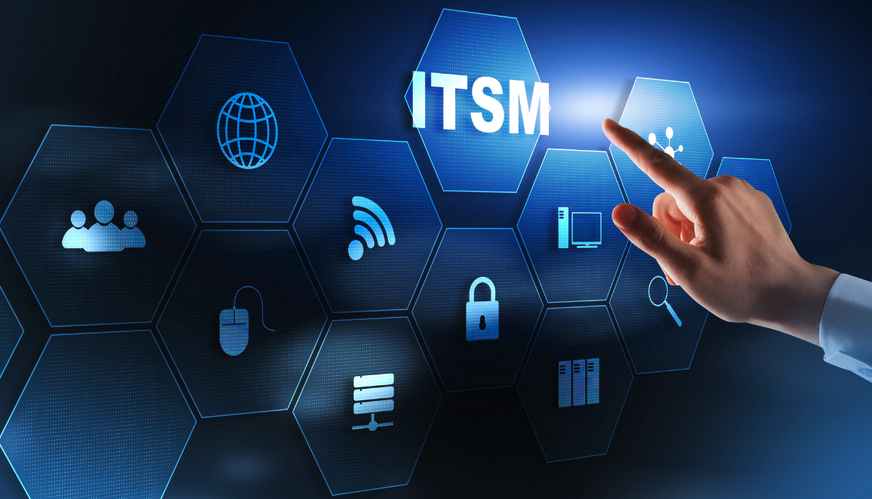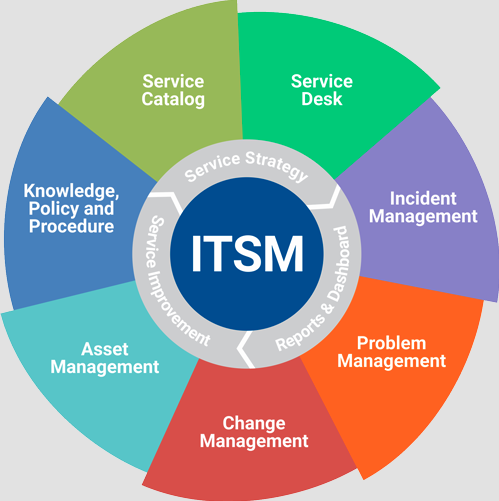
IT Services Management Framework (Image by The Business Journal)

IT Services Management Framework (Image by The Business Journal)
The exact number of IT Service Management framework (ITSM) is not fixed, as new methodologies and adaptations emerge over time. Because every business has its own unique approach.
But, for sure, IT Service Management encompasses the activities and policies designed to plan, deliver, operate, and control IT services offered to customers.
The importance of ITSM lies in its ability to align IT processes and services with business objectives, ensuring that technology supports and enhances business operations rather than hindering them.
This alignment is critical to organizational efficiency. ITSM streamlines processes, reduces costs, improves service quality and improves response times.
For that reason, we are going to take a closer look at ITSM. We will discuss a number of popular ITSM frameworks that are ready to be customized to meet your business needs.
ITSM frameworks are structured sets of best practices, processes, and tools for managing the lifecycle of IT services.
ITSM frameworks provide guidance for delivering and supporting IT services in a way that aligns with business objectives and meets customer expectations.
Now, here’s the cool part: ITSM frameworks are all about keeping your IT services customer-centric and top-notch.
Imagine having a roadmap for designing, delivering, supporting, and continuously improving your IT services.
The main goal? It’s to keep your IT services reliable, current, and ready to adapt to whatever new challenges your business faces.
But wait, there’s more. These frameworks aren’t a one-size-fits-all deal. Each business is unique, right?
So, different companies might click better with certain frameworks, depending on their size, industry, and specific needs.
And here’s where it gets interesting. Some frameworks might zoom in on the nitty-gritty processes, while others might spotlight things like governance or ongoing enhancement.
The real beauty of ITSM frameworks is how they bend and flex. They’re not set in stone.
Instead, think of them as a tailor-made suit for your organization. They shape to fit the unique contours of your business.
When you bring IT Service Management (ITSM) frameworks into your enterprise, you’re essentially setting up a solid, structured way to handle your IT services.
This approach comes with a bunch of key benefits. Let’s walk through what this could mean for your business.
First off, we’re talking about boosting efficiency. Imagine having a playbook for all your IT moves – that’s what these frameworks offer.
This smooths out communication too, helping your IT folks and business teams stay on the same page, solving problems faster.
Now, think about cutting costs. These frameworks are like your IT team’s radar, spotting troubles early on to dodge big, costly issues later.
Also, they help keep a close eye on your IT gear, making sure it lasts longer and you’re not constantly shelling out for new stuff.
But here’s a big one: making your customers happy. Reliable IT services mean your users are getting what they expect, boosting their trust in you.
Got an IT hiccup? These frameworks help you fix it fast, which means less hair-pulling for everyone involved.
Plus, your IT team has more room to try new things and play with new technologies by streamlining day-to-day operations.
These frameworks help your business stay nimble and adapt quickly to whatever the market or technology throws at you.
Another benefit of the ITSM framework is its support for IT Service Continuity Management (ITSCM). A well-structured ITSM framework provides a foundation for effective ITSCM.
With structured IT service management, organizations can easily identify critical services, assess risks, and implement continuity plans, all of which are key aspects of ITSCM.
For more information on IT Service Continuity Management (ITSCM), please refer to our comprehensive guidelines.
Lastly, there’s the whole governance and compliance angle. These frameworks make it clear who’s responsible for what in your IT world, which means better accountability.
They’re also your ally in keeping up with industry rules and avoiding nasty fines.
The best ITSM framework for your organization is one that fits your unique needs and goals.
Selecting the appropriate option can significantly impact your IT operations, making them more efficient, cost-effective, and customer-oriented.
So, let’s dive deeper into 6 popular ITSM frameworks to help you make the ideal choice for your organization.
ITIL, standing for Information Technology Infrastructure Library, is a star player among ITSM frameworks.
Originally developed by the UK government, it’s now widely used across industries globally.
ITIL is a detailed and flexible approach to IT service management. It covers how to strategize, design, transition, operate and improve services.
ITIL is a toolkit that helps enterprises align IT services with business objectives and meet customer needs efficiently.
What sets ITIL apart is its focus on creating a stable environment that can adapt and grow with the business. ITIL delivers consistent, high-quality IT services.
By adopting ITIL, enterprises can improve service delivery, increase customer satisfaction and streamline their IT processes.
ITIL is a solid framework that offers a structured yet adaptable path for businesses to excel in IT service management.

COBIT is an ITSM framework that stands for Control Objectives for Information and Related Technologies and is particularly useful for those concerned with governance.
COBIT, developed by ISACA, serves as a navigational instrument for IT governance and management. Its purpose is to align IT processes with business goals, ensuring that technology serves business needs effectively.
What makes COBIT unique is its focus on control and risk management. It provides a structured approach to oversee and manage IT risks, while also ensuring compliance with relevant laws and regulations.
This framework helps businesses identify and manage IT-related risks, ensuring they’re always on track towards their strategic objectives.
Enterprises can significantly improve their IT governance by adopting COBIT. COBIT ensures that IT investments align with business priorities, add value, and reduce risks.
For enterprises seeking to achieve strategic goals through effective IT governance and management, COBIT is an invaluable tool.
VeriSM is a relatively new player in the ITSM framework arena, bringing a fresh perspective to managing IT services.
VeriSM stands out by emphasizing service management as a holistic, organizational capability.
Unlike traditional ITSM frameworks that often focus on IT processes, VeriSM integrates service management practices into the entire organization.
The core of VeriSM is its adaptability for a world where IT is integral to all business operations, not just a separate department.
VeriSM helps businesses navigate the complexities of delivering IT services in a fast-paced, digital environment. It’s about being agile, responsive, and customer-focused.
VeriSM’s approach is unique in how it incorporates a range of management practices, from ITIL to Lean and Agile, and fits them within a business’s context.
It’s designed to help organizations make sense of the evolving digital landscape and effectively manage services across all areas, not just IT.
Therefore, VeriSM is an ideal framework for businesses seeking to integrate IT service management with their broader organizational goals and strategies.
FitSM shines in the ITSM framework landscape with its striking simplicity and user-friendliness.
Designed for those just entering the world of structured IT service management, especially smaller organizations, it’s the framework to get you started.
The charm of FitSM lies in its laser focus on the fundamentals. Imagine distilling ITSM to its purest form – that’s FitSM for you.
It cuts through the complexity, offering clear-cut and straightforward instructions for managing IT services. This means less time scratching your head and more time doing what matters.
FitSM approaches service planning and delivery with a gentle touch, unlike more daunting frameworks.
FitSM provides a clear and easy-to-follow path that can grow with your organization, rather than just laying a foundation.
If the thought of a heavy, resource-draining ITSM framework makes you hesitate, FitSM is your breath of fresh air. Perfect for those seeking a straightforward, adaptable approach, it balances simplicity with effectiveness.
FitSM isn’t just an entry point; it’s a smart, practical choice for small to medium businesses, or even as a starting point within larger entities.
FitSM makes ITSM manageable and accessible, no matter where you are in your journey.
DevOps, although not a conventional ITSM framework, has quickly become a key player in the world of IT Service Management.
DevOps is a blend of development (Dev) and operations (Ops), breaking down the silos that often exist between these two areas.
What is intriguing about DevOps is its transformative approach. DevOps is not just a set of processes; it is a mindset shift.
DevOps accelerates the delivery of IT services with a strong focus on continuous improvement by bringing development and operations teams together.
This synergy leads to faster deployment of new features, more stable operating environments, and a proactive stance on problem-solving.
DevOps is a methodology that can significantly improve the speed and reliability of IT service delivery for businesses.
DevOps enables software development and IT operations to be more responsive to business needs by fostering a culture of continuous feedback and iterative improvement.
This approach offers a pathway to innovate faster, respond more quickly to market changes, and deliver higher value to customers.
SAFe, or the Scaled Agile Framework, is an advanced ITSM framework that’s particularly suited for larger organizations with complex service management needs.
SAFe is more like a blueprint for scaling agile practices beyond single teams to entire departments or even the whole enterprise.
SAFe integrates agile principles with lean and product development practices, creating a cohesive strategy for managing large-scale software and IT projects.
The real pull of SAFe is how it manages to balance flexibility with structure. It provides a robust yet adaptable framework that guides organizations through the complexities of scaling agile.
This means not just managing IT projects efficiently but aligning them with the business’s strategic goals.
SAFe facilitates coordinated planning, development, and delivery processes, ensuring that IT initiatives are in sync with the business objectives and market demands.
For businesses grappling with the challenge of scaling agile practices across multiple teams or departments, SAFe offers a structured yet flexible pathway.
So, SAFe is about transforming the way large-scale IT projects are managed and delivered, ensuring they contribute effectively to the business’s success.
In our exploration of IT Service Management (ITSM) frameworks, it’s clear that having a robust ITSM is no longer a luxury; it’s a necessity for businesses in today’s digital landscape.
What makes ITSM frameworks so urgent? The digital world moves fast, and downtime can be costly.
An effective ITSM framework helps you respond quickly and effectively, minimizing disruptions to your business and your customers.
Each ITSM framework is unique, offering different approaches and tools to suit your business’s specific needs.
It is important to keep in mind that subjective evaluations should be excluded unless clearly marked as such.
This is not a one-size-fits-all approach, rather a customized approach to improving your IT processes.
So, why wait? Strengthen your ITSM framework today and set your business up for a successful, tech-driven future.
ITSM framework is an investment that pays off in smoother operations, satisfied customers, and a resilient IT infrastructure.